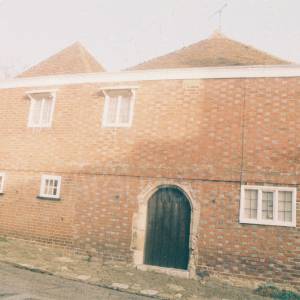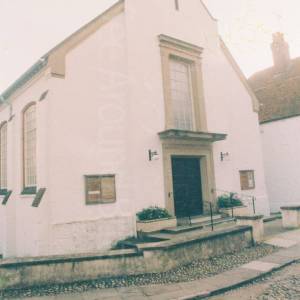Lamb House, Rye, Sussex
Details
Accessibility
"No onsite parking. Toilets in the courtyard and on the ground floor. Assistance dogs only. Three steps to entrance of building. Ground floor has steps, small rooms. Two flights of stairs to first floor. Partly accessible grounds, some steps, uneven, narrow and loose gravel paths. Seating available.
Steps/uneven terrain:
There are three steps to the entrance of the building. The ground floor has steps and small rooms. There are two flights of stairs to the first floor. The grounds are partially accessible but please be wary of steps and uneven, narrow gravel paths.
Garden: 1. The main garden surfaces are predominantly grass with some occasional stone inlaid or gravel paths. Slopes are minimal. The garden is not accessible by wheelchair users. 2. There are some benches within the garden. 3. There are two steps from the dining room into the garden. 4. Entrance into the garden is via steps from the street."
25th March 2021:
Brief description
2025: "Celebrating 300 years of history and literary connections in a stunning Georgian house. Red-brick fronted house with literary associations - both Henry James and E. F. Benson lived here.
The garden:
Lamb House has a walled garden, one of the largest gardens in the old town of Rye; it was designed as we see it today by a friend of Henry James called Alfred Parsons.
Find roses, lilies, spring bulbs and many herbaceous varieties bordering the lawn which ensure continuous colour and interest throughout the year.
Also to be found in the garden are the graves of James’ much loved dogs. The garden is a tranquil contrast to the busy streets of the town in the summer and sitting beside the pond one can fully understand why James had such affection for his garden. Today the garden is a refuge for visitors and local people alike."
https://en.wikipedia.org/wiki/Lamb_House
2025: "Lamb House is a Grade II* listed 18th-century house situated in Rye, East Sussex, England,[1] and in the ownership of the National Trust.
The house is run as a writer's house museum. It has been the home of many writers, including Henry James from 1897 to 1914, and later E. F. Benson.[2] Lamb House was built in 1722 by James Lamb, a wealthy wine merchant and local politician.[3] In the winter of 1726 King George I took refuge at the house after his ship was washed ashore at nearby Camber Sands. James Lamb gave up his bedroom for the King, while Mrs Lamb gave birth to a baby boy during the night. The child was named George and the king consented to be the boy's godfather.[4]
A detached Garden Room, with a large bay window overlooking the street, was built at right angles to the house in 1743, and originally served as a banqueting room.[3] Both Henry James and E. F. Benson later used the Garden Room as a base for their writing during the summer months. The Garden Room was destroyed by a German bomb in 1940.[5][4]
Benson wrote lovingly of both the garden and house, which he renamed "Mallards", in his popular Mapp and Lucia novels.[6] Lamb House is the subject of Joan Aiken's supernatural book The Haunting of Lamb House (1993), comprising three novellas about residents of the house at different times, including James and Benson (both of whom also wrote ghost stories).[7]
Other tenants have included the novelist Rumer Godden, the author and academic A. C. Benson, the author and politician H. Montgomery Hyde, the artist and publisher Sir Brian Batsford,[8] politician William Mabane, 1st Baron Mabane,[9] the literary agent Graham Watson,[10] the actor Dominic Rowan and his family,[11] and the writers John Senior and Sarah Philo. In 1950 the widow of Henry James's nephew gave Lamb House to the National Trust.[8] Some of James's personal possessions are on display, and there is an extensive walled garden, designed by Alfred Parsons at the request of Henry James, which is open to the public along with the house.[2]
In 2006 Lamb House was subject to extensive exterior refurbishment, including the application of bird control proofing measures to prevent seagulls from nesting and blocking the internal parapet drainage systems. The measures included the use of a new technique of horizontal parallel wires to prevent gulls from landing. Several sections of stonework and the copper roof were replaced. The works lasted for three months, from April to June.
As of 2018, the house will no longer be tenanted and the first floor will be open to the public for the first time.[12]"
Address
National Trust - Lamb House
West Street
Rye
TN31 7ES
lambhouse@nationaltrust.org.uk
Phone
01797 222909
Website
https://www.nationaltrust.org.uk/visit/sussex/lamb-house
Directions
"From Market Road Turn right onto High Street, Turn left onto West Street and arrive at Lamb House on right at the top of hill."
Opening Times
Always check with the venue directly for up-to-date information including opening times and admission charges as they may be subject to change
Transport
"By train
Rye main line station, (Southern Railway) short walk up hill. Rye Station Building, Station Approach, Rye TN31 7AB Walk north-east on Rye Platform 2 Turn right towards Station Approach Turn right towards Station Approach Turn left onto Station Approach Station Approach turns slightly right and becomes Market Rd Turn right onto High St Turn left onto West St and arrive at Lamb House on right at the top of hill."
Amenities
"Toilets are located in the courtyard and on the ground floor of the house. Only assistance dogs are allowed at Lamb House.
Highlights:
House: Red-brick fronted Georgian house with literary associations.
The White Parlour: Historic exhibition space currently displaying 300 years of history at Lamb House.
Walled garden: Walled garden with roses, lilies, spring bulbs and many herbaceous varieties bordering the lawn.
Vegetable Garden: Award-winning Vegetable Garden during its Victorian origins, filled with seasonal produce."
Travel Information
For further travel information please see: www.traveline.info
Or call Traveline on 0871 200 22 33
(Calls cost 12p per minute plus your phone company's access charge)








